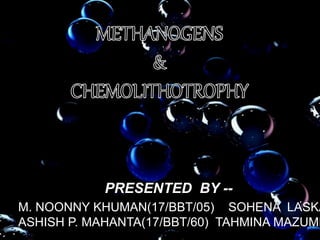
Methanogens and chemolithotrophy
- 1. PRESENTED BY -- M. NOONNY KHUMAN(17/BBT/05) SOHENA LASKA ASHISH P. MAHANTA(17/BBT/60) TAHMINA MAZUMD
- 2. Contents What are chemolithotrophs Chemolithotrophy definition Chemolithotrophy metabolism II. Chemolithotrophy I. Methanogens What are Methanogens Pathway for methane synthesis III. Conclusion IV. Reference
- 3. Methanogens
- 4. WHAT ARE METHANOGENS •Strict anaerobes •Obtain energy by converting CO2 , H2 , formate , methanol , acetate & other compounds either methane or methane & CO2 . •Ability to produce methane anaerobically. •Autotrophic when growing on CO2 & H2 . •Largest group of Archaea . •Methanogens thrive in anoxic environment rich in organic matter. The rumen and intestinal system of animals , freshwater and marine sediment , swamps and marches hotsprings , anoxic sludge digester and anaerobic protozoa.
- 5. SIGNIFICANCE – Energy source for heat and electricity . Fuel. ORDERS -- Based on overall shape , 16SrRNA sequence , cell wall chemistry and structure , membrane lipids and other features , methanogens can be divided into 5 orders – i. Methanobacteriales ii. Methanococcales iii. Methanomicrobiales iv. Methanosarcinales v. Methanopyrales
- 7. Unit co-factors of METHANOGENS - i. H4MPT (Tetrahydromethanopterin) ii. MFR (Methanofuran) iii. Co-enzyme M(2 mercaptoethane sulphonic acid) iv. Co enzyme F420 & F430 Pathways of Methane production – i. Hydrogenotrophic ii. Acetoclastic iii. Methylotrophic
- 8. PATHWAY FOR METHANE SYSTHESIS FROM CO2 :- CHOMFR- Formyl methanofuran CH3SCOM- Methyl sulphur coenzymeM COM- 2marcaptoethane sulphonic acid or coenzymeM H4MPT- Tetra hydroxy methanofuran / methanopterin HSHTP- Marcaptoheptanoy theorenine phosphate Co – factors – Methanopterin (MPT) , Methanofuran ( MFR)
- 10. • Certain groups of prokaryotes , obtain their energy from the oxidation of reduced inorganic compounds such as sulfide, ammonia and hydrogen, and use carbon dioxide as carbon source. These organisms are called chemolithotrophs or chemoautotrophs. • The term "chemolithotrophy" refers to a cell’s acquisition of energy from the oxidation of inorganic compounds, also known as electron donors. WHAT ARE CHEMOLITHOTROPHS
- 11. • Chemolithotrophs generate ATP through oxidative phosphorylation. • Organisms thrive in specific environments. • Do not require external carbon source. • These microbes obtain electrons for the electron transport chain from the oxidation of inorganic molecules rather than NADH generated by the oxidation of organic nutrients. • Much less energy is available from oxidation of inorganic molecules than from the complete oxidation of glucose to Co2
- 18. Conclusion • Methanogens are responsible for the production of methane in ruminants. • Methanogens play a vital ecological role in anaerobic environments by removing excess hydrogen and fermentation products produced by other forms of anaerobic respiration. Lithotrophs participate in many geological processes, such as the formation of soil and the biogeochemical cycling of carbon, nitrogen and other elements. Lithotrophs also associate with the modern day issue of acid mine drainage. Lithotrophs may be present in a variety of environments, including deep terrestrial subsurfaces, soils, mines and in endolith communities.
- 22. 1. Methanogenic bacteria are Archaea that are – a. Strict anaerobes that obtain energy through the synthesis of methane b. Strict anaerobes that obtain energy through the consumption of methane c. Strict aerobes that energy through the synthesis of methane 2. Which of the following have been suggested to be among the first living organism to have developed ? a. Methanococcus b. Methanopyrales c. Methylococcus d. NOTA 3. Chemotrophs – a. Are all heterotrophs b. Are all autotrophs c. NOTA d. Maybe heterotrophs or autotrophs
- 23. 4. Microorganisms are classified into phototrophs and chemotrophs on the basis of – a. Carbon source b. Energy source c. Electron source d. Nutrients 5. Chemotrophs obtain energy from organic or inorganic compounds by – a. Oxidation b. Reduction c. Oxidoreduction d. Hydrolysis 6. Chemolithotrophic autotrophs include – a. Sulphur oxidizing bacteria c. Nitrifying bacteria b. Hydrogen bacteria d. All of the above 7. The microorganism which can use organic compounds as the sole energy, carbon and electron sources are – a. Photolithotrophic autotrophs b. Chemoorganotrophic heterotrophs c. Chemolithotrophic autotrophs d. Photoorganotrophs
